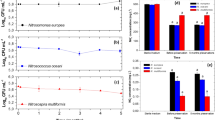Abstract
The effect of Ni2+ on the growth and functional gene expression of the pure culture and co-culture of Acidithiobacillus thiooxidans and Leptospirillum ferriphilum has been studied. Compared with the pure culture, the co-culture showed a stronger sulfur and ferrous ion oxidation activity. At 100 mM, A. thiooxidans in co-culture grew faster and had 48 h shorter lag phases. The cell number of A. thiooxidans in co-culture was about 5 times higher than that in pure culture. The existence of A. thiooxidans in co-culture activated the expression of some metal resistance genes in L. ferriphilum at least 16 h in advance. A. thiooxidans in co-culture tends to chose more efficient pathways to transport nickel ion, ensuring the export of heavy metal was faster and more effective than that in pure culture. All the data indicated that there were synergetic interactions between iron- and sulfur-oxidizing bacteria under the stress of Ni2+.






Similar content being viewed by others
References
Akcil A, Ciftci H et al (2007) Role and contribution of pure and mixed cultures of mesophiles in bioleaching of a pyritic chalcopyrite concentrate. Miner Eng 20(3):310–318
Akinci G, Guven DE (2011) Bioleaching of heavy metals contaminated sediment by pure and mixed cultures of Acidithiobacillus spp. Desalination 268(1–3):221–226
Ballester A, González F et al (1992) The use of catalytic ions in bioleaching. Hydrometallurgy 29(1–3):145–160
Brenner K, You L et al (2008) Engineering microbial consortia: a new frontier in synthetic biology. Trends Biotechnol 26(9):483–489
Cabrera G, Gómez JM et al (2005) Influence of heavy metals on growth and ferrous sulphate oxidation by Acidithiobacillus ferrooxidans in pure and mixed cultures. Process Biochem 40(8):2683–2687
Coram NJ, Rawlings DE (2002) Molecular relationship between two groups of the genus Leptospirillum and the finding that Leptospirillum ferriphilum sp. nov. dominates South African commercial biooxidation tanks that operate at 40 °C. Appl Environ Microbiol 68(2):838–845
Diels L, Dong Q et al (1995) The czc operon of Alcaligenes eutrophus CH34: from resistance mechanism to the removal of heavy metals. J Ind Microbiol 14(2):142–153
Dopson M, Baker-Austin C et al (2003) Growth in sulfidic mineral environments: metal resistance mechanisms in acidophilic micro-organisms. Microbiology 149(8):1959–1970
Duddridge JE, Wainwright M (1980) Heavy metal accumulation by aquatic fungi and reduction in viability of Gammarus pulex fed Cd2+ contaminated mycelium. Water Res 14(11):1605–1611
Eitinger T, Mandrand-Berthelot MA (2000) Nickel transport systems in microorganisms. Arch Microbiol 173(1):1–9
Fagan M, Saier M Jr (1994) P-type ATPases of eukaryotes and bacteria: sequence analyses and construction of phylogenetic trees. J Mol Evol 38(1):57–99
Fu B, Zhou H et al (2008) Bioleaching of chalcopyrite by pure and mixed cultures of Acidithiobacillus spp. and Leptospirillum ferriphilum. Int Biodeterior Biodegradation 62(2):109–115
Hooshangi S, Bentley WE (2008) From unicellular properties to multicellular behavior: bacteria quorum sensing circuitry and applications. Curr Opin Biotechnol 19(6):550–555
Kato S, Haruta S et al (2005) Stable coexistence of five bacterial strains as a cellulose-degrading community. Appl Environ Microbiol 71(11):7099–7106
Liu Y, Yin H et al (2011) The effect of the introduction of exogenous strain Acidithiobacillus thiooxidans A01 on functional gene expression, structure and function of indigenous consortium during pyrite bioleaching. Bioresour Technol 102(17):8092–8098
Mikolay A, Nies D (2009) The ABC-transporter AtmA is involved in nickel and cobalt resistance of Cupriavidus metallidurans strain CH34. Antonie Van Leeuwenhoek 96(2):183–191
Nies DH (2003) Efflux-mediated heavy metal resistance in prokaryotes. FEMS Microbiol Rev 27(2–3):313–339
Nogami Y et al (1997) Inhibition of sulfur oxidizing activity by nickel ion in Thiobacillus thiooxidans NB1-3 isolated from the corroded concrete. Jpn Soc Biosci Biotechnol Agrochem 61:1373–1375
Novo M, da Silva A et al (2000) Thiobacillus ferrooxidans response to copper and other heavy metals: growth, protein synthesis and protein phosphorylation. Antonie Van Leeuwenhoek 77(2):187–195
Nurmi P, Özkaya B et al (2009) Inhibition kinetics of iron oxidation by Leptospirillum ferriphilum in the presence of ferric, nickel and zinc ions. Hydrometallurgy 97(3–4):137–145
Penev K, Karamanev D (2009) Kinetics of ferrous iron oxidation by Leptospirillum ferriphilum at moderate to high total iron concentrations. Adv Mater Res 71–73:255–258
Plumb JJ, McSweeney NJ et al (2008) Growth and activity of pure and mixed bioleaching strains on low grade chalcopyrite ore. Miner Eng 21(1):93–99
Qiu M-q, Xiong S-y et al (2005) A comparison of bioleaching of chalcopyrite using pure culture or a mixed culture. Miner Eng 18(9):987–990
Qiu M, Xiong S et al (2006) Efficacy of chalcopyrite bioleaching using a pure and a mixed bacterium. J Univ Sci Technol Beijing Miner Metall Mater 13(1):7–10
Sampson MI, Phillips CV (2001) Influence of base metals on the oxidising ability of acidophilic bacteria during the oxidation of ferrous sulfate and mineral sulfide concentrates, using mesophiles and moderate thermophiles. Miner Eng 14(3):317–340
Watling HR (2008) The bioleaching of nickel-copper sulfides. Hydrometallurgy 91(1–4):70–88
White C, Shaman AK et al (1998) An integrated microbial process for the bioremediation of soil contaminated with toxic metals. Nat Biotech 16(6):572–575
Wu C-b, Zeng W-m et al (2007) Bioleaching of chalcopyrite by mixed culture of moderately thermophilic microorganisms. J Cent South Univ Technol 14(4):474–478
Zhang Y-s, Qin W-q et al (2008) Bioleaching of chalcopyrite by pure and mixed culture. Trans Nonferr Met Soc China 18(6):1491–1496
Zhang R-b, Wei M-m et al (2009) Application of real-time PCR to monitor population dynamics of defined mixed cultures of moderate thermophiles involved in bioleaching of chalcopyrite. Appl Microbiol Biotechnol 81(6):1161–1168
Zouboulis AI, Matis KA et al (1997) Biosorption of metals from dilute aqueous solutions. Sep Purif Rev 26(2):255–295
Acknowledgments
This research was supported by the National Key Basic Research Project of China (No. 2010CB630901), High Tech Research and Development Program (863 Program: 2012AA061502), and National Natural Science Foundation (No. 31070104 and No. 31100033) of China.
Author information
Authors and Affiliations
Corresponding authors
Additional information
Communicated by Erko Stackebrandt.
Rights and permissions
About this article
Cite this article
Xu, Y., Yin, H., Jiang, H. et al. Comparative study of nickel resistance of pure culture and co-culture of Acidithiobacillus thiooxidans and Leptospirillum ferriphilum . Arch Microbiol 195, 637–646 (2013). https://doi.org/10.1007/s00203-013-0900-z
Received:
Revised:
Accepted:
Published:
Issue Date:
DOI: https://doi.org/10.1007/s00203-013-0900-z




